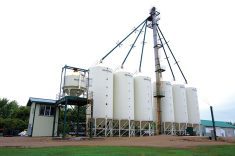One year ago — almost to the day — Trevor Schriemer walked outside to find his family’s greenhouse operation engulfed in flames. So when a natural gas pipeline ruptured near Otterburne and burst into flames early Saturday morning, his first thought was “not again.”
“It was terrifying, all of a sudden you hear this massive explosion and I look out out of the windows and I thought my greenhouses were burning down… again, and on the exact anniversary,” he said.
The fire is out, but the Schriemer Family Farm is finding heat hard to come by. The four-acre greenhouse complex runs on natural gas boilers, or at least it did until Manitoba Hydro cut off the natural gas supply on Saturday.
Read Also

Mazergroup’s Bob Mazer dies
Mazergroup’s Bob Mazer, who helped grow his family’s company into a string of farm equipment dealerships and the main dealer for New Holland machinery in Saskatchewan and Manitoba, died July 6 from cancer.
“Now we’re running exclusively on diesel from St. Anne’s Co-op, they’re here every eight hours filling us up,” Schriemer said, adding he’s glad he included a diesel backup when upgrading the boiler system last year.
“As long as St. Anne’s can sustain us, and as long as my son can stay awake in the boiler room…. we will keep going,” he said.
The Schriemers’ predicament was an extreme version of the circumstances many thousands to residents and many farm owners were plunged into last weekend. After the explosion, the pipeline supplying gas to the region was shut down and depressurized to contain the fire. That left about 4,000 residents in New Bothwell, Niverville, Otterburne, St-Pierre-Jolys, Grunthal, St. Malo, Dufrost, Ste. Agathe, Marchand and Kleefeld without heat just as a blizzard set in, closing roads and plunging temperatures into the -30 C range.
“You could pretty much stand outside… in your shirt sleeves, if it was any closer it would have melted all the plastic in my greenhouse.” Trevor Schriemer
It also set in motion a whole series of municipal emergency response plans enacted by local officials and volunteers.
Warm-up shelters enacted as part of local emergency plans stood empty as people opted to stay home relying on electrical space heaters, or leaving to be with friends and family unaffected by the outage.
Two warming shelters set up at the New Bothwell Christian Fellowship Church and Grunthal Abundant Life Fellowship church were open but remained unused overnight Sunday, said Heather Chambers Ewen of the RM of Hanover’s emergency team. People appeared to have chosen to sit tight, and were saying they were shutting up the interiors of their homes to keep one or two rooms warm with alternative heat sources, she said.
Warm-up shelters stayed empty
“People are being very self-sufficient at this time,” Chambers Ewen said. “Temperatures are lowering in people’s homes but everyone is trying their best to use good judgment in their own homes and in their own situations,” she said.
In Niverville, compressed gas was trucked in to keep the Niverville Heritage Centre warm, and the town was also prepared for a worst-case scenario, noting on its website that there were about 200 cots and blankets stored in the community to be set up should there be an electrical grid failure. The warm-up shelter was not opened after town officials determined there was no need for the service.
In St. Pierre-Jolys, an emergency prevention order had been declared, essentially giving special powers to mayor and council to take charge of the situation, said Brian Martel, another emergency measures information officer.
Martel said across the region volunteers have been being mobilized to call on and check in on residents in affected municipalities to make sure everyone was remaining safe.
“We’ll be doing a checkup with residents and making phone calls to see if there’s anything they need, and to give information,” he said.
One of the emergency officials big concerns as people hunkered down at home was that they use only approved space heaters. Barbecues, kerosene heaters or temporary gas space heaters pose a serious risk because they produce harmful levels of carbon monoxide as well as fire risks.
Businesses in St. Pierre-Jolys were at a virtual standstill as the week began said Arlene Enns, co-owner of the ordinarily busy Le Routier Restaurant. Except for hydro crews dropping in, their place was dead. Staff were making toast and coffee for them using electrical appliances, she said.
“We’re serving very limited fare and it’s not warm in here, but it’s temperate,” she said.
Farm contingency plans
Unconfirmed reports, meanwhile pegged as many as 200 farm owners in the region to be affected one way or another.
Cory Rybuck, general manager for Manitoba Egg Producers, said the egg farmers they’d been in contact with said they were improvising and faring alright.
“We do have some some producers without heat, but it’s not affecting them… typically with layers they generate their own heat,” he said. “There are some barns that do use supplemental heat, they would either be using propane, or diesel or electric, not natural gas, so we haven’t heard from those folks since it all happened,” he said.
“Those who have backup plans are putting them into effect, and those that don’t are managing to make do somehow,” he said.
A spokesman for Manitoba Agriculture, Food and Rural Development said all affected livestock producers in the region would follow existing contingency plans.
Dr. Dale Douma, acting chief veterinary officer, said by Sunday the department had mapped out the extent of the natural gas outage as well as the swine and poultry premises that were hooked up to the natural gas line. These industry associations were contacted and provided with a map and list of their members that were affected over the weekend, he said.
“We remain in close contact with these associations and they’ve been asked to contact MAFRD if additional support is needed,” he said, adding that MAFRD was aware of some operations that had been affected and disrupted by the natural gas outage as of Monday, but additional support had not been requested at that time.
A provincial government spokesperson said Premier Greg Selinger met with local officials Monday about how the communities were coping with the situation to see if they needed any additional support.

Heat could have melted greenhouse
The explosion, which produced flames reportly 200 to 300 metres high and a roar akin to a jet plane, was so close that he could feel the heat from it, Schriemer said.
“You could pretty much stand outside… in your shirt sleeves, if it was any closer it would have melted all the plastic in my greenhouse,” he said.
In full production, with greenhouses bursting with tomato and cucumber crops requiring steady temperatures, their backup plan also includes leaving lights — which provide 12 degrees of heat — on longer.
But you can only rob plants of darkness for so long, he said, adding that increased demands on electricity in the wake of the gas outage had brought its own problems.
“Manitoba Hydro was desperate to reduce the load… we cut our lights early yesterday (Sunday) to help out the grid, and avoid rolling blackouts,” he said. “It’s been a struggle.”
Schriemer said he knows neighbours are also struggling with the loss of natural gas and heat.
“People who have chicken barns, hog barn, all their gas has been cut as well, not to mention all the houses were people are shivering,” he said, adding his own father been searching for extra space heaters since the outage.
“You can’t buy a heater in the city of Winnipeg anymore,” he said.
At press time Manitoba Emergency Measures Organization was continuing to work with affected communities. Nine natural gas tanker trucks were in place at all health-care facilities in the region to ensure the heat stayed on.




















